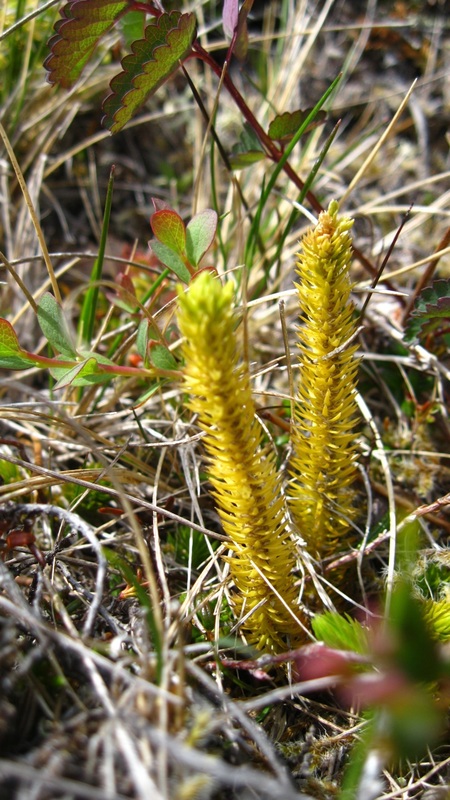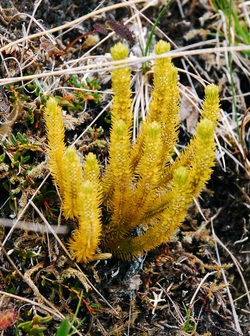Fir clubmoss, alpine fir-moss, mountain clubmoss • Huperzia selago, Lycopodium selago, Huperzia halaekalae
|
NOTE: The plants shown here are likely H. halaekalae, as their stems are 'pipe-cleaner-like' and they have yellow-green leaves that are not widely spreading from the stem. These leaves have wide bases as well. These plants were found in a lower elevation habitat than is reported for H. halakalae by E-Flora BC, but this habitat - a boggy lookout spot on Calvert Island - has many other species not usually found at that lower elevation.
|
Identification
Clubmosses are vascular plants that reproduce by spores (like mosses and lichens) rather than seeds (like most other vascular plants). Ferns and horsetails share these characteristics. Fir clubmoss has upright stems that grow from a horizontal rooting system. The stems may be unbranched or branch in two several times, grow to 5-20 cm in height, and may appear singly or in clusters of 2-10. It ranges in colour from yellow-green to olive green, and has crowded, scale-like leaves that vary from lance to egg-shaped with pointy tips. Leaves may be held fairly tight against the stem, or may be wide-spreading.
Habitat & Range
Fir clubmoss is found in a variety of habitats from low to alpine elevations. Habitats include bogs, heaths, cliffs, rocky glades and slopes, forests, tundra, and talus slopes. It is scattered throughout areas with suitable habitat, but is rarely abundant. It is circumpolar, and is found throughout most of Canada and some areas of the northern United States (see range map).
Similar Species
The taxonomy of Huperzia selago is uncertain, as it appears to sometimes be split into H. chinensis, H. occidentalis, H. halaekalae, and H. selago. According to the Illustrated Flora of British Columbia (information available on E-Flora BC) H. halaekalae leaves are yellow-green or light green and widest near their base. The leaves are lance-shaped and only pull slightly away from the stem. The ''pipe-cleaner-like' stems usually grow in dense clusters of 5-10 or more. H. chinensis (also H. miyoshiana) has dark green, longer (5-10 mm long) and thinner leaves (to 0.5 mm wide), with leaf tips curved back. H. occidentalis has dark green, wide-spreading leaves. H. selago is yellow-green, has reproductive buds (gemmae) that form whorls, and is restricted to North America. Based on these descriptions, the plants in the photos above are likely H. halaekalae. As the status of these separate species is currently uncertain, H. selago is used here as a broader species identification.
Human Uses
Clubmosses are used in traditional Chinese medicine to treat acetylcholine deficiencies. Fir clubmoss specifically has anecdotally been linked to treatment of glaucoma, which is related to acetylcholine deficiency. The plant contains huperzine, a form of which (huperzine A) is used in the treatment of Alzheimer's symptoms. Fir clubmoss was once harvested for huperzine, though now the chemical can now be produced in a lab.
Intriguing Info
Clubmoss spore powder is very flammable, and once was used in fireworks, lighting stages, and flash photography.
Clubmosses are vascular plants that reproduce by spores (like mosses and lichens) rather than seeds (like most other vascular plants). Ferns and horsetails share these characteristics. Fir clubmoss has upright stems that grow from a horizontal rooting system. The stems may be unbranched or branch in two several times, grow to 5-20 cm in height, and may appear singly or in clusters of 2-10. It ranges in colour from yellow-green to olive green, and has crowded, scale-like leaves that vary from lance to egg-shaped with pointy tips. Leaves may be held fairly tight against the stem, or may be wide-spreading.
Habitat & Range
Fir clubmoss is found in a variety of habitats from low to alpine elevations. Habitats include bogs, heaths, cliffs, rocky glades and slopes, forests, tundra, and talus slopes. It is scattered throughout areas with suitable habitat, but is rarely abundant. It is circumpolar, and is found throughout most of Canada and some areas of the northern United States (see range map).
Similar Species
The taxonomy of Huperzia selago is uncertain, as it appears to sometimes be split into H. chinensis, H. occidentalis, H. halaekalae, and H. selago. According to the Illustrated Flora of British Columbia (information available on E-Flora BC) H. halaekalae leaves are yellow-green or light green and widest near their base. The leaves are lance-shaped and only pull slightly away from the stem. The ''pipe-cleaner-like' stems usually grow in dense clusters of 5-10 or more. H. chinensis (also H. miyoshiana) has dark green, longer (5-10 mm long) and thinner leaves (to 0.5 mm wide), with leaf tips curved back. H. occidentalis has dark green, wide-spreading leaves. H. selago is yellow-green, has reproductive buds (gemmae) that form whorls, and is restricted to North America. Based on these descriptions, the plants in the photos above are likely H. halaekalae. As the status of these separate species is currently uncertain, H. selago is used here as a broader species identification.
Human Uses
Clubmosses are used in traditional Chinese medicine to treat acetylcholine deficiencies. Fir clubmoss specifically has anecdotally been linked to treatment of glaucoma, which is related to acetylcholine deficiency. The plant contains huperzine, a form of which (huperzine A) is used in the treatment of Alzheimer's symptoms. Fir clubmoss was once harvested for huperzine, though now the chemical can now be produced in a lab.
Intriguing Info
Clubmoss spore powder is very flammable, and once was used in fireworks, lighting stages, and flash photography.
References
Douglas, G.W., Meidinger, D., and Pojar, J (Eds.). (2001). Illustrated flora of British Columbia. (Vol. 5). Victoria, BC: Ministry of Sustainable Resource Management and Ministry of Forests, Province of British Columbia. Pp. 276-279.
Huperzia chinensis (Christ) Czern. In Klinkenberg, Brian. (Ed.). E-Flora BC: Electronic Atlas of the Plants of British Columbia. Lab for Advanced Spatial Analysis, Department of Geography, University of British Columbia, Vancouver. Accessed 11/04/2014.
Huperzia haleakalae (Brack.) Holub. In Klinkenberg, Brian. (Ed.). E-Flora BC: Electronic Atlas of the Plants of British Columbia. Lab for Advanced Spatial Analysis, Department of Geography, University of British Columbia, Vancouver. Accessed 11/04/2014.
Huperzia occidentalis (Clute) Kartesz & Gandhi. In Klinkenberg, Brian. (Ed.). E-Flora BC: Electronic Atlas of the Plants of British Columbia. Lab for Advanced Spatial Analysis, Department of Geography, University of British Columbia, Vancouver. Accessed 11/04/2014.
Pojar, J. and MacKinnon, A. (1994). Plants of Coastal British Columbia. Vancouver, BC: Lone Pine Publishing. P. 433.
Pojar, J. and MacKinnon, A. (2013). Alpine plants of British Columbia, Alberta, & Northwest North America. Vancouver, BC: Lone Pine Publishing. P. 495.
Authors and editors of page
Kelly Fretwell and Brian Starzomski (2014).
Douglas, G.W., Meidinger, D., and Pojar, J (Eds.). (2001). Illustrated flora of British Columbia. (Vol. 5). Victoria, BC: Ministry of Sustainable Resource Management and Ministry of Forests, Province of British Columbia. Pp. 276-279.
Huperzia chinensis (Christ) Czern. In Klinkenberg, Brian. (Ed.). E-Flora BC: Electronic Atlas of the Plants of British Columbia. Lab for Advanced Spatial Analysis, Department of Geography, University of British Columbia, Vancouver. Accessed 11/04/2014.
Huperzia haleakalae (Brack.) Holub. In Klinkenberg, Brian. (Ed.). E-Flora BC: Electronic Atlas of the Plants of British Columbia. Lab for Advanced Spatial Analysis, Department of Geography, University of British Columbia, Vancouver. Accessed 11/04/2014.
Huperzia occidentalis (Clute) Kartesz & Gandhi. In Klinkenberg, Brian. (Ed.). E-Flora BC: Electronic Atlas of the Plants of British Columbia. Lab for Advanced Spatial Analysis, Department of Geography, University of British Columbia, Vancouver. Accessed 11/04/2014.
Pojar, J. and MacKinnon, A. (1994). Plants of Coastal British Columbia. Vancouver, BC: Lone Pine Publishing. P. 433.
Pojar, J. and MacKinnon, A. (2013). Alpine plants of British Columbia, Alberta, & Northwest North America. Vancouver, BC: Lone Pine Publishing. P. 495.
Authors and editors of page
Kelly Fretwell and Brian Starzomski (2014).





